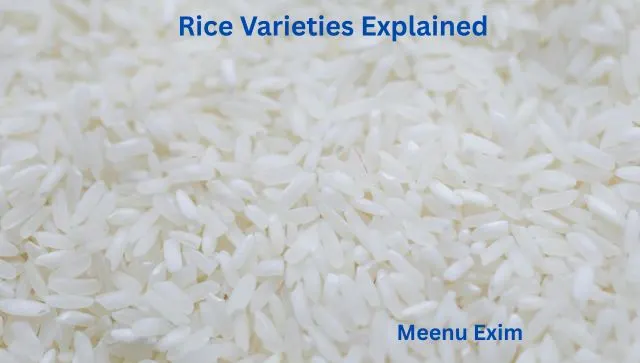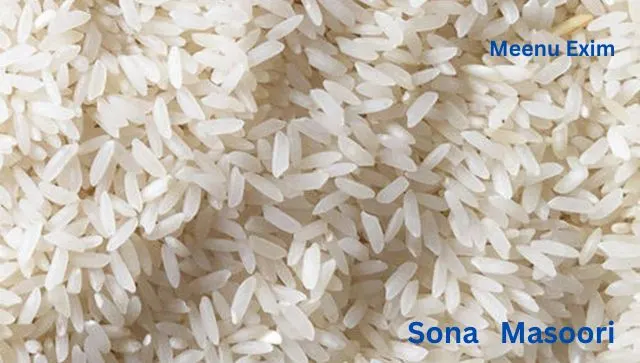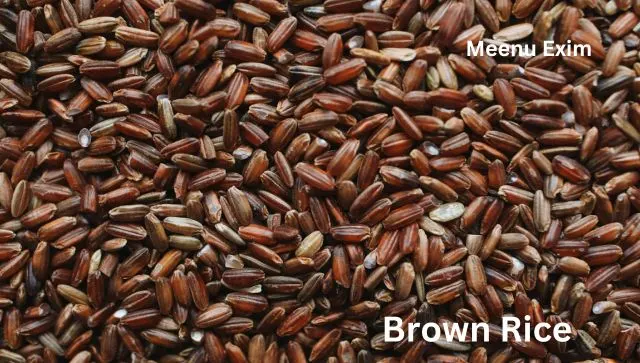1.Introduction:
Rice is an essential staple food for over half of the world’s population. It has been cultivated from thousands of years on earth. Globally, about 525 million tons of rice is produced annually. Rice varieties are broadly classified by grain length (long, medium, short), each offering distinct culinary characteristics.
2.Understanding Different Rice varieties:

There are thousands of rice varieties available across the world. But they are most commonly divided into three main categories based on their grain length.
By understanding the basic characteristics and culinary uses of these main rice varieties, you’ll be able to choose the perfect grain for any meal. So, Lets take a look on the main three categories.
Long-Grain Rice:
These grains are slender and at least three to five times longer than their width. They tend to cook up light, separate & fluffy. The grains remain distinct and do not stick together. This is due to their higher amylose starch content.
Common Varieties of Long grain rice:
Basmati:
Famous for its distinctive nutty, floral aroma and non-sticky texture. Ideal for biryanis, pilafs, and Indian/Middle Eastern curries. This rice is king of all rice varieties.
Basmati Rice is further having many categories Some of them are :
1121 Basmati Rice:
Characteristics: This is perhaps the most popular and Basmati variety globally, especially for export. It is known for its extra-long grains (often exceeding 8.35 mm uncooked) These grains elongate significantly (up to 2.5 times or even more) when cooked. This variety has a strong aroma, a fluffy, non-sticky texture, and excellent separation of grains.
Uses: Ideal for premium biryanis, pulaos, and other festive & special occasion dishes where presentation and distinct grains are important.
You can also find the details of1121 Basmati rice in our product details
1718 Basmati Rice:
1718 Basmati rice is a premium, long-grain aromatic. It was developed as an improved version of the popular Pusa 1121 Basmati. It can withstand challenging weather conditions & offers enhanced resistance to bacterial leaf blight. This leads to higher yields and shorter ripening times. It is also famous for its distinct nutty and floral aroma & extra-long slender grains (averaging 8.35-8.40 mm). It has fluffy & non-sticky texture when cooked, 1718 Basmati rice is highly sought after for its exceptional culinary qualities.
You can also Find details of 1718 rice in our product details
Pusa Basmati Rice:
Characteristics: Pusa Basmati (including varieties like Pusa Basmati 1, Pusa Basmati 1121, Pusa Basmati 1509, Pusa Basmati 1718, etc.) are hybrid and semi-dwarf varieties developed by the Indian Agricultural Research Institute (IARI).
They were developed for higher yields and earlier maturity. But most of the good qualities of traditional Basmati, including aroma, grain elongation, and non-stickiness are retained in this rice variety
Uses: Very versatile, often used for daily cooking, restaurant dishes, and large-scale catering due to its good quality and affordability relative to some traditional varieties. Pusa 1121 is particularly popular for its length and aroma.
Dehradun Basmati (Type 3):
Characteristics: This is a traditional Indian Basmati variety having its origin from the Dehradun region of Uttarakhand. It is highly valued among the rice varieties for its flavor, long grains & unique “popcorn” aroma. It often has a slightly softer texture after cooking when compared to some other varieties.
Jasmine Rice:
This rice is known for its soft texture & fragrant, slightly sweet aroma. It is somewhat sticky but still separate. It is a staple food in Thai and other Southeast Asian cuisines. Jasmine rice is also often called “Thai fragrant rice” or “Hom Mali rice. The term “Jasmine rice” is derived from jasmine flower famous for its intense fragrance.
Standard Long-Grain White Rice:
This variety refers to a general category of rice that has been milled to remove the husk, bran, and germ, resulting in a white, starchy endosperm. It is characterized by its long, slender kernels which typically measuring 6.6 mm or more in length. The grains are often three to four times longer than its width.
Unlike highly aromatic rice varieties like Basmati or Jasmine rice the standard long grain white rice l has a mild, neutral flavor and aroma. This makes it highly versatile. When cooked, the grains tend to remain separate and fluffy. This characteristic makes it ideal for dishes where individual grains are desired e.g.: pilafs, stir-fries, and as a side dish for curries, stews, and casseroles.
2.Medium-Grain Rice :
These grains are shorter and plumper than long-grain rice. The grains are typically two to three times longer than their width.
On cooking they become moist, tender, and slightly sticky. They retain some chewiness but also have a tendency to cling together. They have a balanced starch content. This makes them good at absorbing flavors.
Common Rice Varieties of medium grain Rice :
Arborio:
This is an Italian rice variety with a characteristic white dot in the center. It’s rich in amylopectin starch, which is released slowly during cooking, creating a creamy texture while still maintaining a slight bite (al dente). This makes it prime choice for classic Italian risotto.
Valencia/Bomba:
This is a Spanish rice variety known for its ability to absorb a large amount of liquid without becoming mushy. This makes it ideal for paella, the iconic Spanish rice dish.
Sona Masoori:

This is a popular Indian medium-grain rice which is used for daily meals and various South Indian dishes.
3.Short-Grain Rice
These grains are plump and nearly round. They often appear as wide as they are long. They are very starchy and become soft, tender, and highly sticky when cooked. They release a lot of starch (amylopectin) during cooking. This makes them clump together
Common Rice Varieties of Short Grain Rice:
Sushi Rice (e.g., Koshi Hikari, Calrose):
This rice is specifically cultivated to have the perfect sticky yet soft texture for making sushi rolls, onigiri, and other Japanese dishes where the rice needs to hold its shape.
Glutinous Rice (Sticky Rice/Sweet Rice):
This rice variety is extremely sticky and opaque when cooked. Contrary to its name it is gluten-free. This rice is popular for its use in Southeast Asian desserts (like mango sticky rice) and savory dishes.
4. Beyond White Rice: Healthy & unique options.
While white rice is widely used as a staple food, it is a refined grain, meaning the bran and germ (the most nutritious parts) are removed during processing. This makes white rice less nutrient-dense compared to other varieties.
Common Rice Varieties Beyond White Rice :
1 Brown Rice:

Brown rice is a whole grain, meaning only the outermost hull is removed, leaving the bran and germ intact.
Nutritional Benefits of Brown rice:
High in Fiber: Brown rice has Significantly more fiber than white rice. This help in digestion, promoting satiety (feeling of fullness), and help regulating blood sugar levels.
Rich in Vitamins and Minerals: Brown rice is a good source of B vitamins (especially B1, B3, B6), magnesium, manganese, phosphorus, and zinc.
Antioxidants: It Contains polyphenols and flavonoids that protect cells from damage. This reduces the risk of chronic diseases.
Lower Glycemic Index: Compared to white rice, brown rice has a lower glycemic index, meaning it causes a slower and more gradual rise in blood sugar. This is beneficial for blood sugar management, for those suffering with diabetes.
Taste/Texture: This rice has nutty flavor and a chewier texture than white rice.
2.Black Rice (Forbidden Rice):
Black Rice Gets its deep black (which often turns purple when cooked) color from a high concentration of anthocyanins, the antioxidants which are also found in blueberries and blackberries. It’s also a whole grain, retaining its bran and germ.
Nutritional Benefits of Black rice :
Highest Antioxidant Activity:
Black rice is considered a “superfood” among all rice varieties due to its remarkably high antioxidant content, particularly anthocyanins. These powerful antioxidants combat oxidative stress & reduce inflammation. These antioxidants also protect against various chronic diseases, including heart disease and certain cancers.
Good Source of Fiber and Protein: This rice is good source of fiber & contributes to satiety and digestive health.
Vitamins and Minerals: This rice contains iron, zinc, magnesium, and Vitamin E.
Taste/Texture: This rice has mild nutty flavor with a slightly sweet hint and a chewy texture.
Red Rice:
Similar to black rice, red rice gets its reddish color from anthocyanins. It is also a whole grain.
Nutritional Benefits:
Rich in Antioxidants: This rice is abundant in flavonoid antioxidants (like anthocyanins, myricetin, and quercetin). Thus, it offers potent anti-inflammatory and antioxidant properties. Some studies suggest its antioxidant properties are even more than black and brown rice in certain aspects.
Higher in Iron and Zinc: Red rice is richer in these essential minerals in comparison to white, black, or brown varieties,
Good for Heart Health: The fiber and antioxidants contribute to managing cholesterol levels. This reduces the risk of heart disease.
Blood Sugar Regulation: Lower glycemic index of this rice helps stabilize blood sugar levels.
Taste/Texture: Similar to basmati rice, this rice also has nutty aroma and taste along with a slightly chewy texture.
Wild Rice:
Rice varieties are not complete without wild riceIt is technically not a rice, but rather a grain from an aquatic grass native to North America. It is considered a whole grain.
Nutritional Benefits :
Excellent Protein Source: It has higher protein than most of the true rice varieties.
Good Fiber Content: It has more fiber thus it helps in digestion and promotes fullness.
Rich in Vitamins and Minerals: It Contains B vitamins (niacin, folate, B6), magnesium, phosphorus, zinc, and manganese.
Antioxidants: This rice possesses powerful antioxidant and lipid-lowering properties. So, it is beneficial for cardiovascular health.
Low in Calories and Fat: It is a relatively low-calorie option in comparison to other rice varieties
Taste/Texture: It has distinctive earthy, nutty flavor and a firm, chewy texture.
3. Conclusion :
There are lot of rice varieties available all over the world .When choosing healthy rice varieties, prioritize whole grains (brown, black, red, wild rice) as they retain the nutrient-rich bran and germ.
Thus, these rice varieties can offer more fiber, vitamins, minerals, and antioxidants compared to refined white rice.
Each rice variety is having unique flavor, aroma and benefits. so, experimenting can be a delicious way to boost your nutrition!